As a beginner gardener, you need five essential tools for success. First, a hand trowel is invaluable for planting and digging. Next, pruning shears help maintain plant health by removing dead branches, so opt for high-quality bypass shears. Garden gloves protect your hands from dirt and thorns while enhancing your grip. A watering can is necessary for delivering water efficiently—choose one with a long spout for delicate seeds. Finally, a soil meter allows you to measure soil health, ensuring informed decisions about nutrient needs. Keep exploring to uncover additional tools and tips that can boost your gardening experience.
Key Takeaways
- A hand trowel is essential for planting, digging, and transferring soil, making it a must-have for novice gardeners.
- Pruning shears help maintain plant health by removing dead or damaged branches, promoting growth and shape.
- Garden gloves protect hands from thorns, dirt, and provide better grip, ensuring comfort while gardening.
- A watering can is vital for efficiently delivering water to plants, especially with a long spout for delicate seedlings.
- A soil meter allows gardeners to measure soil parameters, helping to identify nutrient deficiencies and determine proper watering frequency.
Hand Trowel
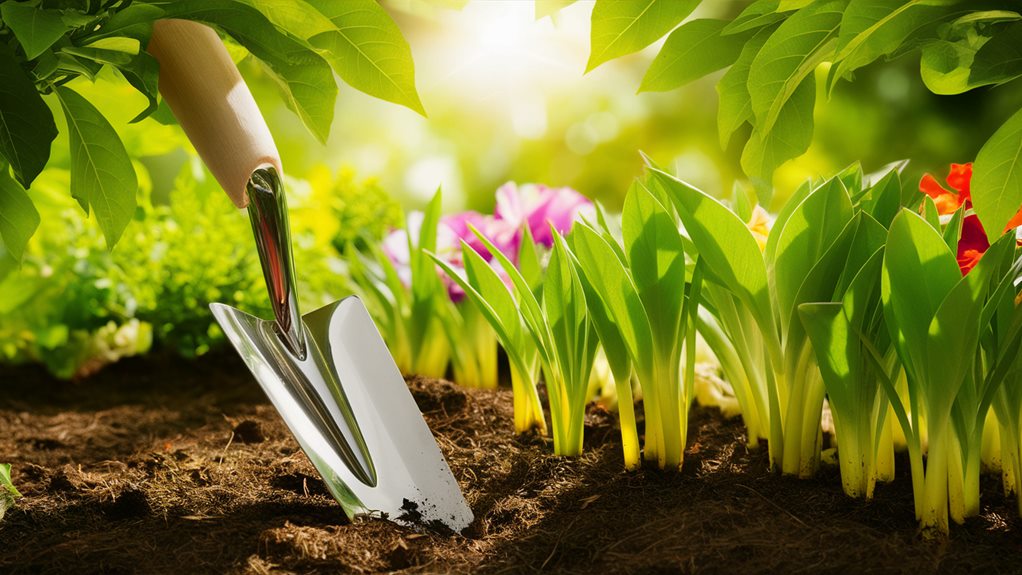
A hand trowel is a necessary tool for any novice gardener, and you'll find it invaluable for various tasks. This adaptable tool allows you to dig, weed, plant, and transplant with ease, making it a key component of a well-equipped gardener's toolkit. To maximize its effectiveness, mastering proper technique is essential.
When using your trowel, grip the handle firmly and position the blade at a slight angle to slice through soil. Use a scooping motion to lift soil, avoiding excessive pressure that could strain your wrist.
Proper technique not only enhances your gardening experience but also reduces fatigue during prolonged use. As you work, remember to keep your movements fluid and controlled. This way, you'll maintain precision and avoid damaging surrounding plants.
Trowel maintenance is equally significant. After each gardening session, clean your trowel with warm, soapy water and dry it thoroughly to prevent rust. Inspect the blade for any nicks or bends; if you spot damage, use a sharpening stone to restore its edge.
Regular maintenance not only extends the life of your trowel but also guarantees peak performance for all your gardening tasks.
Pruning Shears
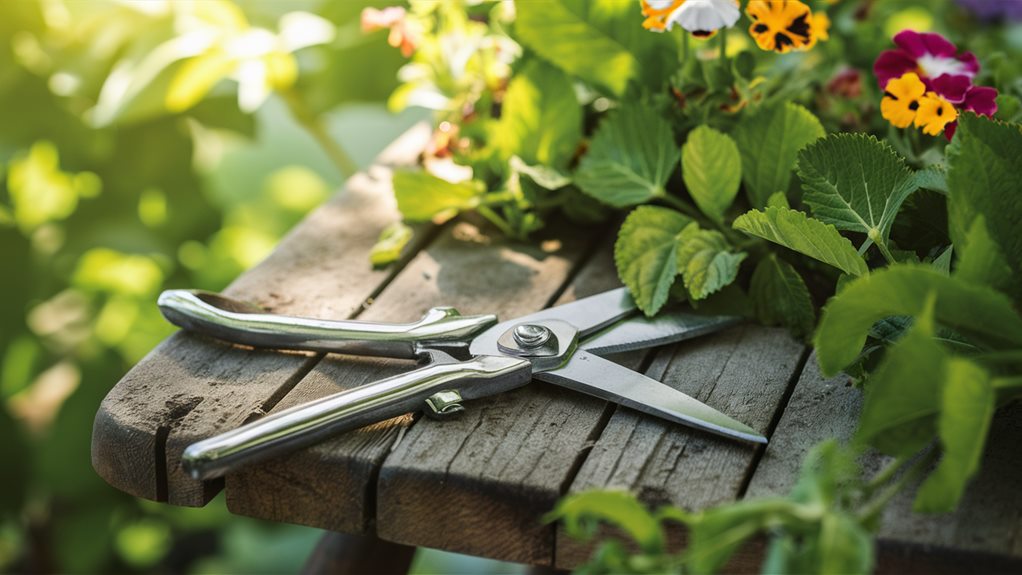
When you venture into gardening, pruning shears become essential for maintaining healthy plants and promoting growth. These necessary tools help you shape your plants, remove dead or diseased branches, and encourage new growth. To maximize their effectiveness, you need to master proper pruning techniques.
Start by inspecting your plants to determine which branches to cut. Focus on removing any dead, damaged, or crossed branches, as these can hinder your plant's development. Selecting shears made from high-quality materials, such as premium SK5 steel blades, can greatly enhance your pruning experience.
Choosing the right pruning shears is vital for a successful gardening experience. Look for shears that feel comfortable in your hand and offer a clean, sharp cut. There are various types available, such as bypass shears, which are ideal for live stems, and anvil shears, better suited for cutting through dead wood.
As a beginner, opting for bypass shears is usually a safe bet, as they provide cleaner cuts and promote faster healing.
Always keep your shears sharp and clean. Dull blades can damage your plants and introduce disease. Regularly clean the blades with rubbing alcohol to prevent the spread of pathogens between plants. When pruning, make sure to cut at a slight angle, just above a leaf node or bud, to encourage healthy growth.
Garden Gloves
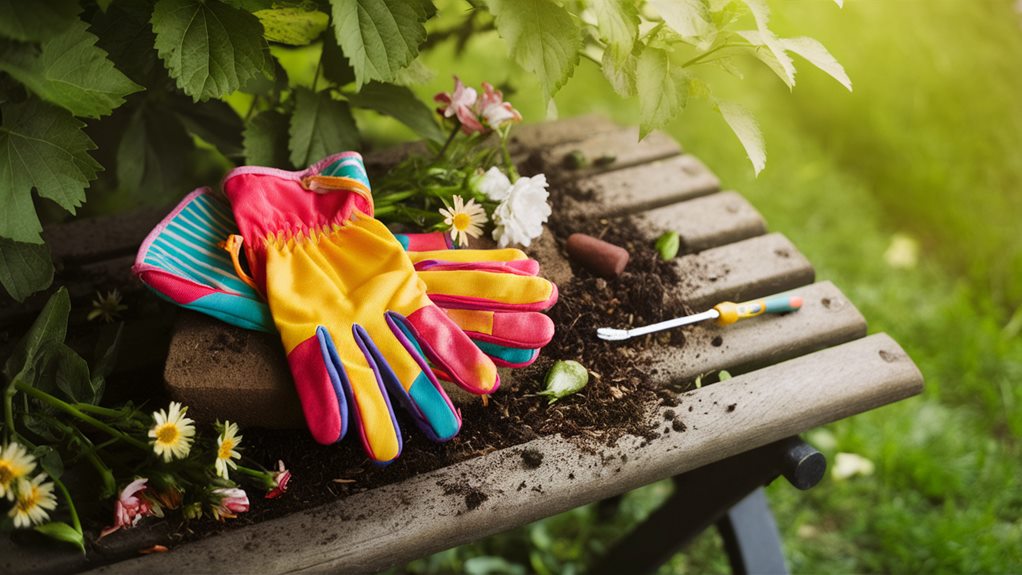
Choosing the appropriate garden gloves is crucial for safeguarding your hands while working in the soil. Not only do gloves shield your skin from thorns and dirt, but they also enhance your grip and dexterity, making gardening tasks easier. When selecting gloves, consider glove sizing to [SECURE] a snug fit. Too loose, and you risk losing control; too tight, and you'll feel discomfort.
There are various material options available, each with its own benefits. Here's a breakdown of some common glove materials to help you choose:
| Material | Pros | Cons |
|---|---|---|
| Leather | Durable, offers good protection | Can be stiff, less breathable |
| Cotton | Lightweight, breathable | Not water-resistant, wears quickly |
| Rubber | Waterproof, easy to clean | Can be less flexible, traps heat |
| PVC | Chemical resistant, affordable | Less durable than leather |
| Nitrile | Excellent grip, puncture-resistant | Not as breathable as cotton |
When you're picking gloves, also consider the tasks you'll be doing. For general gardening, lightweight cotton or nitrile might work best, while heavy-duty leather is ideal for tougher jobs.
Ultimately, the right gloves will make your gardening experience more enjoyable, allowing you to dig, plant, and prune with confidence. So, invest some time in finding a pair that fits well and suits your gardening needs. Your hands will thank you!
Watering Can
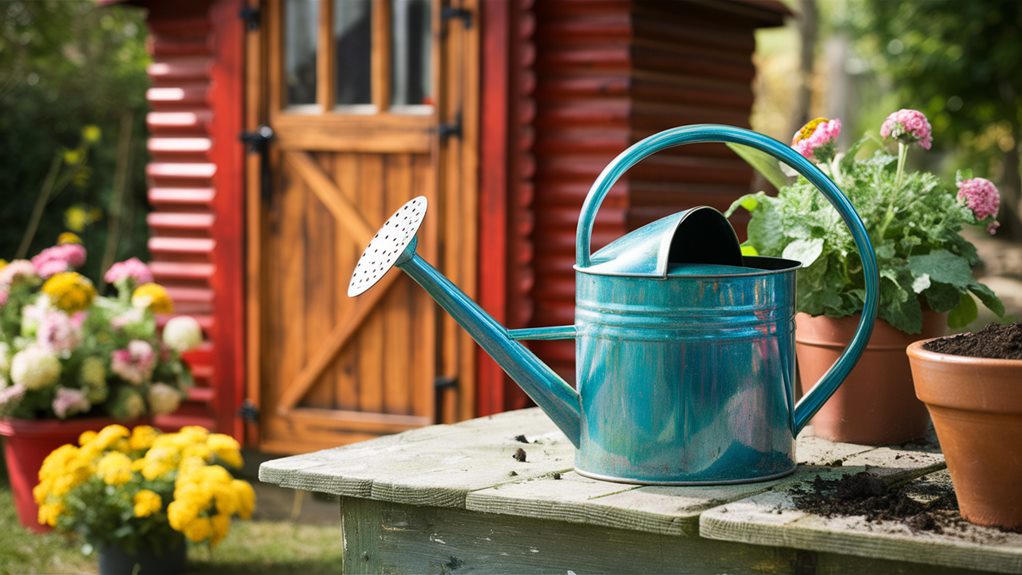
Selecting the right watering can is necessary for effectively nourishing your plants and maintaining a healthy garden. The watering can you choose plays a pivotal role in your watering routine, influencing both the efficiency of water delivery and the health of your chosen plants.
When you're selecting a watering can, consider factors like size, material, and spout design. Additionally, using organic fertilizers can greatly boost plant growth, as they provide slow nutrient release and promote healthier ecosystems, which is crucial for a flourishing garden increasing crop yields.
For proper watering techniques, a can with a long spout allows you to reach those hard-to-access areas in your garden. It's especially helpful when you're tending to delicate seedlings that require precise watering.
A larger can may hold more water, reducing the number of trips you make to refill it, while a smaller can can be easier to handle, especially for container gardening.
Additionally, when choosing the right plants for your garden, consider how much water they need. Some plants thrive in moist soil while others prefer dryer conditions. A watering can that features a removable rose attachment lets you customize the water flow, giving you control over how much moisture each plant receives.
Opt for a lightweight material, like plastic or aluminum, which makes handling easier, especially during longer watering sessions. As you cultivate your garden, remember that the right watering can is a crucial tool that can help you establish and maintain a flourishing environment.
Soil Meter
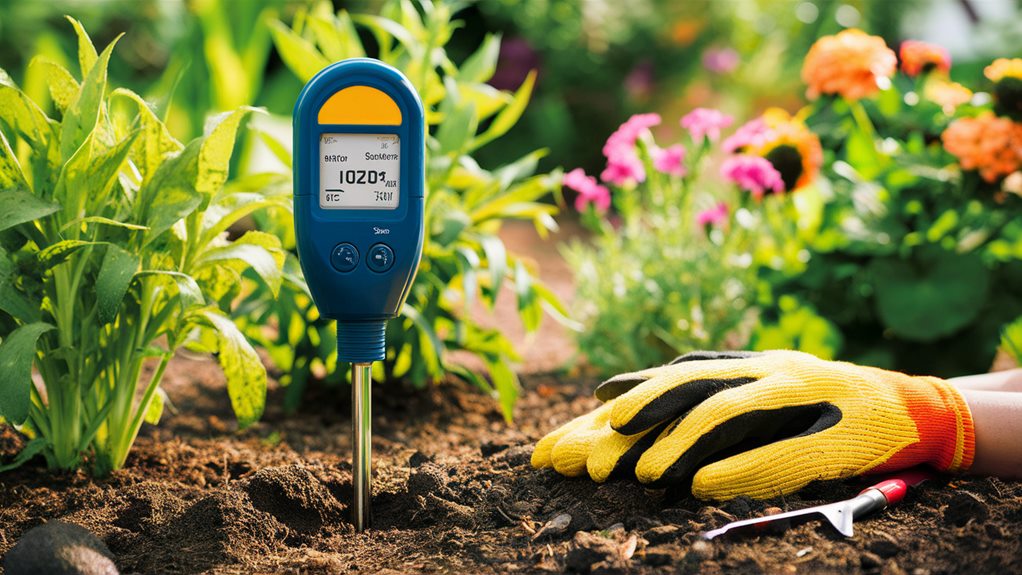
A soil meter is a crucial tool for any novice gardener seeking to cultivate a flourishing garden. This convenient device measures vital soil parameters, including pH levels, moisture content, and nutrient availability, assisting you in making informed decisions about your garden's requirements.
Understanding plant nutrition is essential for the well-being of your garden. A soil meter can pinpoint nutrient deficiencies, enabling you to amend the soil with the specific fertilizers your plants need. By regularly monitoring nutrient levels, you can optimize your plants' growth balance.
Moreover, knowing your soil's moisture content is important for establishing an effective watering frequency. Overwatering can result in root rot, while underwatering can cause stress to your plants. A soil meter provides real-time data, so you can water only when necessary, preventing wastage and promoting healthy roots.
Using a soil meter is simple. Just insert the probe into the soil, and check the display for immediate insights. Many models even offer digital readings, making it simple to track changes over time.
Incorporating a soil meter into your gardening routine nurtures a deeper connection with your plants and enhances your gardening skills. As you become adept at interpreting the readings, you'll gain confidence in your ability to nurture a lively garden. So, invest in a soil meter and witness your gardening journey thrive!
Frequently Asked Questions
What Are the Best Plants for Beginner Gardeners to Start With?
If you're starting your gardening journey, consider easy-to-grow flowers like marigolds and zinnias for vibrant colors.
For vegetables, try radishes and lettuce; they thrive with minimal effort.
Low-maintenance herbs like basil and mint are perfect for adding flavor to your meals, while succulents like aloe and jade plant require little water.
These options will boost your confidence and help you cultivate a flourishing garden that feels rewarding and inviting.
How Often Should I Water My Garden?
Picture your plants basking in the sun, thirsty for a drink. Establish a watering schedule based on their needs, considering plant placement and soil type. Test the soil moisture regularly; if it's dry an inch down, it's time to water. Confirm proper drainage solutions to prevent waterlogging. Typically, watering every few days works well, but adjust based on weather and plant growth. With care, your garden will flourish, creating a vibrant oasis.
When Is the Best Time to Plant Seeds?
The best time to plant seeds depends on your climate and the specific crops. Generally, you should consider seed germination rates and local planting schedules.
For warm-season crops, wait until the soil temperature reaches at least 60°F. Cool-season crops can be sown earlier, often in early spring or fall.
Always check your last frost date and plan accordingly to promote growth and maximize yield for your garden.
How Do I Know if My Soil Is Healthy?
Picture your soil as a living tapestry, rich with nutrients. To know if your soil's healthy, start with soil testing to measure nutrient levels. Look for a balance of nitrogen, phosphorus, and potassium. If the nutrients are lacking, consider adding organic amendments like compost or aged manure.
Healthy soil should crumble easily and support diverse microorganisms. By nurturing your soil's health, you create a thriving environment for your plants, fostering a vibrant garden community.
Can I Garden in Small Spaces or Containers?
You can absolutely garden in small spaces or containers! Vertical gardening maximizes your area, allowing you to grow upwards instead of outwards. Creative containers, like recycled jars or hanging pots, can add flair to your space.
Indoor gardening is perfect for apartments, enabling you to cultivate herbs or small vegetables year-round. Just make sure you choose the right plants for your environment, and you'll enjoy a thriving garden, no matter the size!
Conclusion
In gardening, having the right tools can turn a challenging task into a delightful hobby. While a hand trowel helps you dig deep, pruning shears refine your plants' beauty. Garden gloves protect your hands, yet they also connect you to the earth. A watering can nourishes life, while a soil meter guarantees it's thriving. Embrace these essentials, and watch how your garden flourishes, transforming your space from an empty patch of earth to a vibrant sanctuary.

